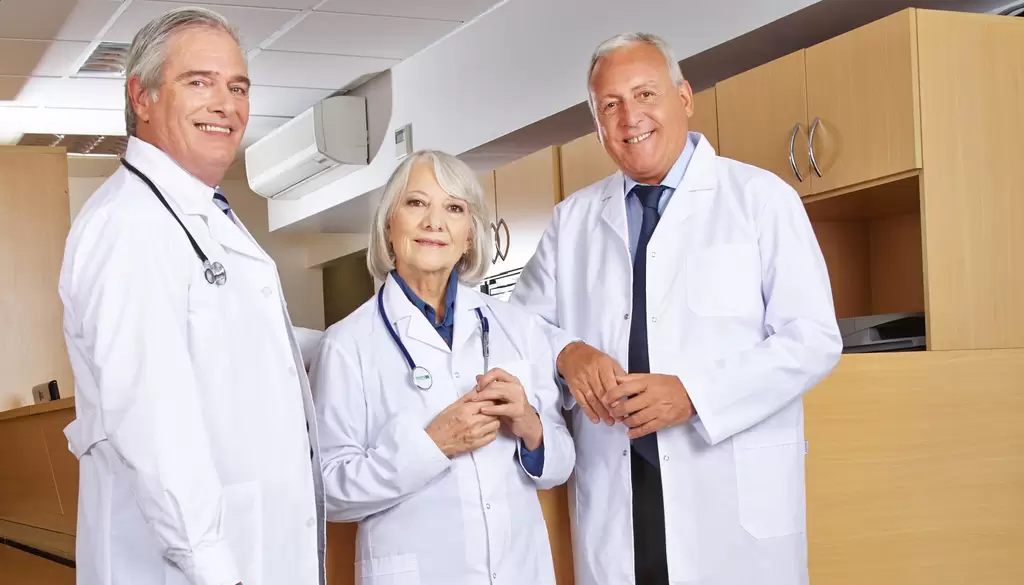Healthcare with Confidence
Aortic stenosis (aortic valve stenosis) is the malfunction of the aortic valve due to its improper formation in the womb.
⇒ To get a Leading Doctor Second Opinion
We select the narrow field physician to treat each specific cardiac disease, making the most effective treatment and helps to improve the quality of life of our patients.
In healthy condition valve has three crescent-shaped flaps and it functions as a door that allow the flow of blood to flow in one direction. Due to this, the blood can flow from the left ventricle into the aorta avoiding flow in the opposite direction – from the aorta to the left ventricle.
Aortic valve stenosis may occur separately or as part of a group of defects on the left side of the heart.
Children with aortic stenosis anatomical characteristics can be expressed as follows:
– the valve has two flaps instead of three;
– thickened folds and therefore the valve does not open fully and correctly;
– valve is located higher or lower than expected.
Malformation of the aortic valve can result in varying degrees of severity of the condition in a child with severe obstruction of the more severe symptoms of heart failure. A child with moderate stenosis appear only some of the symptoms.
Aortic stenosis may be formed during the first eight weeks of pregnancy (birth defect) or develop during the life – in children and adults. In children, in most cases, it is a congenital defect, but there may be rare cases of aortic stenosis caused by arthritis or endocarditis (infection of the heart).
Birth defects of the aortic valve are three to six percent of all congenital heart defects. This disease is three times more common in boys than in girls.
When small stenosis can refrain from operation for many years. But some children stenosis increases as they grow older. In such cases, treatment is necessary.
Symptoms of aortic valve defect
In most cases, the development of a defect in the embryonic stage, severe symptoms in the fetus or shortly after birth. In some cases, the disease is silent, has no symptoms, but appear later during life.
In mild or moderate stenosis, in most cases, no symptoms, and the only symptom may be a heart murmur. Symptoms appear at the moment when it comes to severe stenosis. This symptoms such as fatigue, dizziness on exertion, shortness of breath, increased heart rate and/or irregular heartbeat, chest pain, loss of consciousness during physical exertion.
A child born with severe aortic stenosis should receive urgent medical treatment shortly after birth. Treatment is usually performed by a closed operation (catheterization) for correction of the aortic valve.
Diagnosis of aortic stenosis
Pediatrician can detect abnormal heart murmur (heart murmur) standard listening with a stethoscope. Noise which may indicate a narrowing of the aortic valve, has a special acoustic effect generated when the functioning of the valve. Specialist cardiologist can hear a click during the opening of the valve leaflets.
ECG – a test that evaluates the electrical activity of the heart and detects abnormal heartbeat rhythm and thickening of the heart muscle. ECG device receives electrical signals that pass through the heart muscle and translates them into the scheme of the typical shaped lines. When it comes to mild or moderate stenosis, the test becomes show lines that go beyond the performance standards.
Echocardiography – ultrasound of the heart (ECHO) with an accuracy determines stenosis, including its exact location and severity. This procedure is painless, non-invasive and takes about half an hour. Image created using sound waves. This test is very important because it can detect other problems that often accompany a heart disease such as mitral valve problems and an opening between the ventricles.
Angiography – an invasive test that gives a detailed information on the structure of the heart and its functions. This test is performed under general anesthesia. The test catheter is inserted into an artery leading from the groin to the heart. As the catheter is fed contrast agent used to demonstrate the anatomy of the heart of the child. This procedure at the physician’s discretion, may pass in an operation in which a heart surgeon fixes in place the aortic valve stenosis.
Making a decision about treatment based on such evidence as the age at which a problem is diagnosed, the severity of the defect, the response to drug treatment method.
Children with mild to moderate stenosis can enjoy a normal life and do not require surgery or angioplasty, but they must be under constant supervision of a cardiologist.
Children with more severe stenosis may need a surgery. Nevertheless, the majority of children undergoing surgery or angioplasty, fully restored and normal, healthy life.
Types of surgeries in arterial stenosis
Balloon angioplasty (balloon expanding installation) – cardiologist inserts a thin flexible tube (catheter) into an artery and from there it leads to the heart. When the balloon catheter reaches the aortic valve the physician expands the balloon, thereby restoring valve function. The procedure is performed under general anesthesia and after the observation is usually required within 24 hours in the ICU.
After performing balloon angioplasty, there is the risk of resumption of aortic stenosis in the process of growth and development of the child. In this case, the child will need additional surgery or catheterization. Sometimes the tissue valve may be damaged as a result until adolescence or complications in the future.
Valvotomy (operation expansion valve) – open heart surgery in which the surgeon opens the valve and separate the sash. This operation is carried out in difficult situations, in the presence of complex defects when balloon angioplasty can not solve this problem. In the case of such a strong stenosis assessment of valve is complicated due to calcium deposits and narrowing of the valve ring.
Aortic valve replacement – operation, during which the patient valve is replaced with a prosthesis. This operation is performed in open heart. There are two types of implants – biological valve made of animal tissue, and mechanical valve. Valve replacement also requires receiving blood thinners (Warfarin) for the successful valve functioning.
Ross procedure (pulmonary autograft) – a complex operation that is performed transposition of the aortic and pulmonary valves of the patient. The newest version of the operation involves replacing the aortic valve and the pulmonary valve prosthesis implant mechanical pulmonary artery. The advantage of such operands are biologically and interoperability of the pulmonary valve, displaced in the aortic position, no risk of its destruction and subsequent replacement. Operation is complicated as it requires simultaneous intervention on two major vessels – the pulmonary artery and the aorta. Ross method is very suitable for infants and young children, as the valve, taken from the pulmonary vein may continue to grow in a natural way, parallel to the growth and development of the child.
Konno procedure (aortic annular enlargement) – performed as an open-heart surgery in those cases that require an increase in the ring of the aortic valve.
As a rule, for the treatment of aortic stenosis, the technique is performed in conjunction with the Ross technique. This operation is the Ross-Konno procedure.
In most cases, children who underwent open heart surgery for stenosis then live a normal life without any problems and without any restrictions.
In some cases, a child may require additional surgery to replace the valve.



